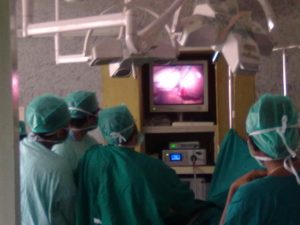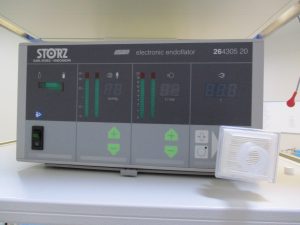Laparoscopy used in the visualization of the internal organ for diagnosis and operative surgical procedures
Operative laparoscopy cannot be carried out adequately using the standard diagnostic laparoscopy or tubal sterilization equipment.
More equipment and a greater variety of instruments needed. This chapter will discuss basic operative laparoscopic instrumentation. Equipment that already available for diagnostic laparoscopy or sterilization will not be discussed.
New instruments are being continuously developed and tested, and some of them may replace the existing

instruments. It is crucial to have a good knowledge of the instruments.
This will facilitate the conduct of surgery, and ensure that the instruments are used wisely so that they will last longer. More importantly, a thorough knowledge of the instruments increases the safety of laparoscopic surgery.
The availability of good and well-maintained laparoscopic instruments is invaluable.
A 10-min straightforward 0° endoscope has a large viewing angle. The best laparoscope for diagnostic as well as for operative surgery. A laparoscope with a laser channel is an alternative.
Laparoscopy Camera and Monitor
These are mandatory for the safe conduct of operative laparoscopy. Maximum image Quality obtained with the use of three-chip technology, high-intensity light (such as xenon or halogen bulbs) and a high-resolution video monitor.
A beam splitter on the camera head for simultaneous viewing by endoscope and monitor decreases the amount of light. A video-recorder to record the surgery utilized for documentation and teaching.
A mobile storage video-cart for the monitor, light source, insufflator, video-recorder or video-printer protects this expensive equipment from premature wear and tear and from accidents.
High-Flow Insufflator
Frequent instrument changes and constant irrigation and aspiration during a procedure lead to a rapid loss of pneumoperitoneum. To maintain pneumoperitoneum, a high-flow insufflator that administers up to 10 liters of gas per minute is a prerequisite.
Laparoscopic procedures involve insufflation (blowing) CO2 gas to a pressure of 12-15mmHg into the abdominal cavity.
Suction Irrigator
A powerful irrigation pump that can deliver a pressure of up to 800 mmHg is invaluable for operative laparoscopy. An example is the Ezhat-Dorsey suction irrigation system. It is an efficient irrigator and it helps to obtain accurate hemostasis.
It can use to separate tissue planes, adhesions, ovarian cyst wall or to flush products of conception from the fallopian tube.
Unipolar and Bipolar and Instruments
Bipolar grasping forceps should always be readily available for hemostasis. These are not replaceable by unipolar forceps or a laser. A 5-mm bipolar microforceps allows accurate coagulation. Among unipolar instruments, my favorites are unipolar cautery with scissors and a 1-mm needle electrode that can be inserted into a built-in channel suction irrigator.
Maximum surgeon prefers the footswitch for the electrosurgical unit for usage. so drape the Footswitch with transparent and damp free to avoid the spillage of fluids
